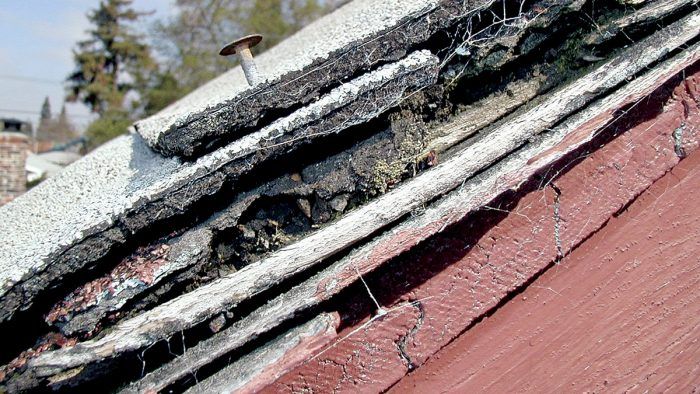Evaluating the State of the Roof
Renovation expert Mike Litchfield outlines the key checkpoints for various types of roofing.

Because water is usually a house’s main enemy, spend time examining the roof—the first line of defense against rain, snow, and ice. Few homeowners would allow a prospective buyer on a sloped roof, whether fearing roof damage or a fall. Even if you’re sure-footed and could obtain permission, it’s probably wiser to stay on the ground. Use your binoculars to take a closer look, unless, of course, you’ll be inspecting a flat roof.
Roof Checkpoints
Sight along the ridge to see if it’s straight. If the ridge sags in the middle, suspect too many layers of roofing or undersize rafters. If the roof sags between rafters, the roof sheathing may be too thin and should be replaced during the next reroofing.
Next, look for flashing at the bases of chimneys and plumbing vents. These objects can dam water and allow it to leak through the roof. If flashing is absent, rusty, or otherwise deteriorated, there’s a good chance of water damage.
The valleys between roof sections should be flashed because they carry a lot of water. Thus, where roof planes converge, you should see either metal flashing down the valley (an open valley) or interwoven shingles (a closed valley).
Drip-edge is specialized flashing that should protrude from beneath the lowest courses of roofing. It allows water to drip clear of the roof. Older homes lacking drip-edges often suffer water damage because water soaks backward under sheathing onto the tops of walls.
Eaves Flashing
Wherever roofs adjoin walls or dormer walls, look for roof-to-wall and step flashings. At brick chimneys, consider whether saddle and step flashings are properly counterflashed.
Asphalt Shingles
If the granular surface of asphalt shingles is worn and if shingles are cupped and dog-eared, it’s time for a new roof. Ditto if gutters contain a significant amount of gravel washed off the surface of the shingles.
If the roofing is lumpy and uneven, there are probably two or more layers of shingles that weren’t well installed. They’ll need to be stripped to the sheathing before reroofing.
Two’s the LimitIf there are two or more layers of roofing, strip the roof to the sheathing before reroofing. The best place to count layers is along the edges. But, as you count, keep in mind that roofers often double the shingles along the edges to stiffen the shingle overhang so water drips freely off its edge. |
Do you see odd-colored shingles? If so, they are probably patches over old leaks. Or if the roof is relatively new and shingles are worn in only one area, perhaps one bundle of shingles was defective.
A roof less than five years old with a large number of loose or missing shingles indicates that the installer’s power nailer was set too deep and drove the nails through the shingles. In this case, that roofing needs to be replaced.
Wood Shingles and Shakes
Shingle wear will almost always be greater on a south-facing roof because that side gets the most sun. If shingle ends are cupping and splitting, plan to reroof soon.
Mossy shingles or shakes are common in wet climates and on shady roof sections. Although moss-covered shingles can be relatively sound, moss retains water and will induce rot.
If the house is in a fire-risk area, insurers may refuse to give a policy on a wood-shingle or wood-shake roof. In this case, replace it with noncombustible roofing.
Slate Shingles
Do not attempt to walk on slate roofs. Even when dry, they’re slippery. Slate also is brittle and breaks easily.
Off-color areas may indicate replacement shingles in an area damaged by a falling tree limb. Later, when you are in the attic, check for water stains on supporting lumber.
If you see rust-colored streaks or cockeyed slates, the installer may have used nails that weren’t galvanized, which by now have rusted through. Although it’s possible to remove and renail slate, the job requires a costly specialist. However, if many nails have rusted through, the roof is dangerous, and the slate should be removed.
Roof Tiles
Stay off tile roofs. Even when the slope isn’t steep, your weight could damage the tiles. Inspect them from an extension ladder or with binoculars.
Look for odd-colored tiles from earlier repairs. Obviously cracked or broken tiles can be replaced, but the job is costly. Under the roof, check for water stains.
Look closely at the ridge. Sagging ridge and rafters suggest too much weight on the framing. It’s a big expense to remove the tiles, bolster or replace sagging rafters, replace sheathing, and then replace tiles.
Metal Roofing
Stay off metal roofs. They are slippery, whether wet or dry.
Even though a rusty roof may not look great, it could be watertight with a lot of years left in it. Roofs with superficial rust can be sanded and repainted. Check for evidence of leaks in the attic.
Roofing panels should be nailed at the high point of metal folds. If you see many nails in the roofing channels themselves—where the water runs—the installation was inept, and you’ll need a new roof.
Built-up Roofing
On older built-up roofs, there were alternating layers of heavy building paper and hot tar, covered with light-colored gravel to reflect sunlight and protect the surface from ultraviolet (UV) damage. More recently, modified bitumen (MB) has largely replaced hot tar and paper. MB roofs typically have cap membranes “torched on” (heated with a propane flame) to fuse them to fiberglass-reinforced interplies, or base coats.
Blisters in built-up roofs are usually caused by trapped water. Individual blisters can be patched with three-course patches, but if blisters are widespread, it’s time to reroof.
Foot traffic can abrade and puncture flat roofs. If you find no evidence of water damage below, you can spot-patch abused areas, lay down new gravel, lock the door to the roof, and consider yourself lucky.
Most leaks occur at turn-ups, where the flat roof joins walls, parapets, and other vertical surfaces. If the turn-up surfaces are cracked, split, sagging, or unpainted, water may have gotten in and done damage. A large amount of tar at the base of walls may indicate inadequate flashing and frequent repairs.
Cracking or blistering around downspout outlets and internal drains indicates inadequate maintenance. Are there wire baskets in the openings? Are openings free of debris? If you have doubts, flush the outlets with a hose to see how well they drain.
Is the flashing around plumbing vents sound? This is not a major repair, but it can indicate
general neglect.
Fine Homebuilding Recommended Products
Fine Homebuilding receives a commission for items purchased through links on this site, including Amazon Associates and other affiliate advertising programs.

Reliable Crimp Connectors

Affordable IR Camera

Handy Heat Gun







